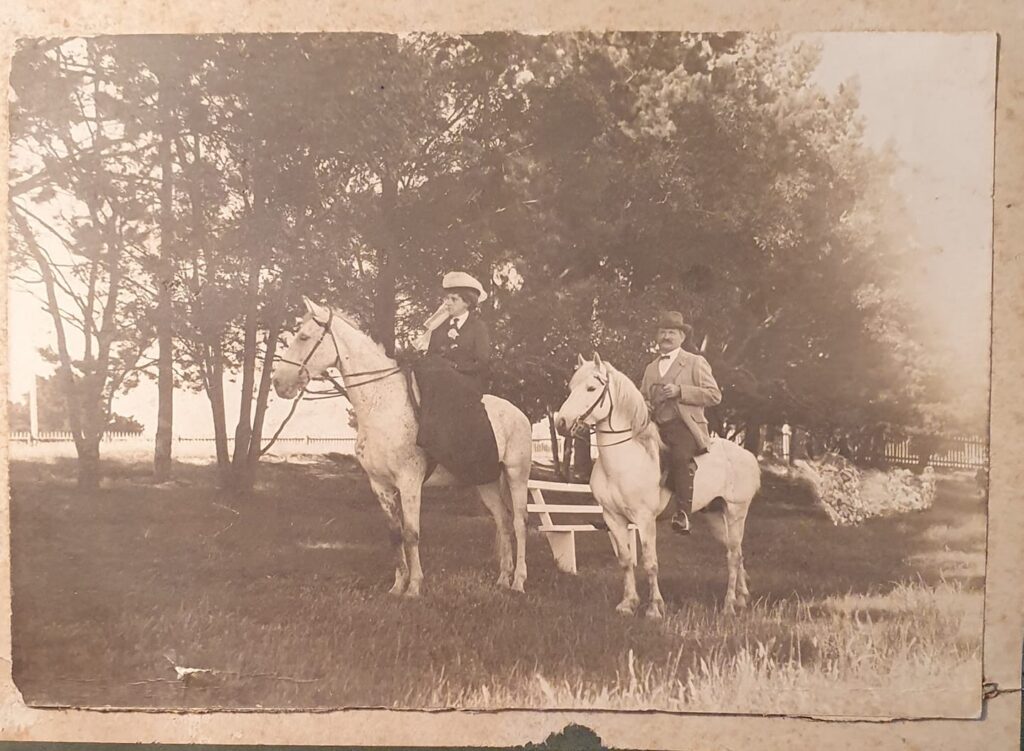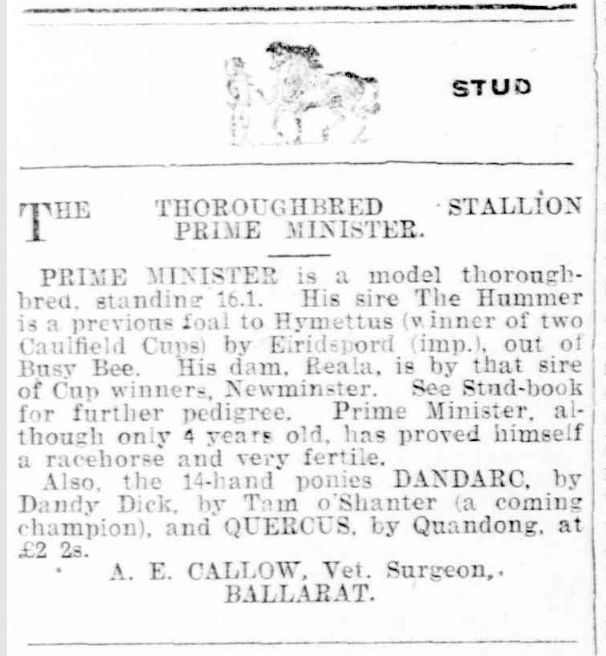Captain A.E. Callow

Waler Data Base @ FaceBook. Image: Capt Callow, receiving reports from Capt J B Leitch, in charge of the Field Veterinary Hospital, Kilmore camp 1911, after the ambulance accident. (Neville Callow photo – Captain Leitch also with the Field Vets.)
Feature photo for this post was sent in by Neville, of his great great grandfather, Captain Andrew Edward Callow. Veterinarian. Tremendous photo! A look through archives reveals a truly remarkable man – this post lists some of his life events – no room to include everything…
And WOW! – some photos of Andrew’s horses were sent in by his granddaughter Leanne, thank you so much! So good to see!


Images: Andrew Callow and his family 1903; Andrew and his wife at Eureka Stockade about 1910 (above). His Mair Street stables 1923 (below). Photos supplied by his great granddaughter Leanne Callow-Steer from her private collection.



Image: Andrew Edward Callow, Virtual War Memorial Photo
His story:
Born 1867, arrived here in 1870 with his parents
Became a keen horseman and athlete
Graduated Veterinary Science in Melbourne with Honours, becoming Australia’s most respected veterinary surgeon in his times
From 1896 taught veterinary science at Ballarat School of Mines, Industry and Science
Also an accomplished farrier, particularly remedial work, and sought after horse dentist; and won shoeing classes at shows
Image: The Australasian, 1st September 1899
Horse breeder – kept four stallions – and helped owners of travelling stallions by taking local bookings for them. Andrew Callow advertised and took bookings for the greater Ballarat area for this stallion, the imported Clydesdale Earl of Millfield, owned by Mr. D. McGregor of Pakenham. He won many show prizes.


Image: Ballarat Star, 9th October 1902
Andrew also owned Quandong for a time, winning champion pony at Ballarat in 1899 with him. He showed those in the ad many times for many ribbons. Prime Minister, like most TB’s back then, was unregistered.
He also had and showed an Arab stallion and a cob stallion.
He showed several mares too. He won spring-cart class and several other classes.
Image: Horse Show on Doveton Street North, Ballarat circa 1910, Victoria Collections
In spring each year a horse show was held in town streets – in fact it was a stallion parade. Andrew always took his stallions along to the Ballarat one.
The public got a good look at prospective sires, and could make a booking.

Attended Light Horse and Artillery training weekends – running their Field Vet Hospital – always several horse patients, attaining the rank of Captain
Honorary Veterinary Surgeon for Lal Lal Fells Turf Club
Showed his stallions, showed his hacks, ponies and cobs in ridden and harness classes, he paid a live-in groom to care for his horses when he was away for work as he travelled a lot
Image below: Single buggy horses in the ring. Ballarat show. Australasian, 19th November 1921

Judged horse classes at shows – Blood Horses, Ponies, Buggy Classes, others, plus judged poultry and pigeons
Bred Dairy Shorthorns and Ayrshires and showed his Dairy Shorthorn bull

Image: Sunraysia Daily, 31st August 1931
This is part of a report about horses he’d attended for the RSPCA, which paid his travelling expenses to the Mallee.
He treated many horses and dairy cattle free for those unable to pay.
He also gave public lectures each year in various places to teach horsemen how to treat their own animals for some things, as there was a dire shortage of vets.
Became a remount buying inspector for the Boer War, attaining Officer Commanding the Veterinary Corps
Became an Inspector of stallions in Victoria once legislation for a Stallion Certificate was required to prove soundness was made law – very busy doing this for many years
Revived the Ballarat Hunt Club in 1906 and rode to hounds
In 1914 his son Auburn, with Andrew’s consent as a legal requirement being only 18, joined the army and went overseas with the 8th Light Horse.
In 1917 Andrew’s other son Nathaniel turned 18 and gained his father’s consent to join up, and also went off to war.
AWM image: Studio portrait of 19007 Sapper (Spr) Nathaniel Thomas Callow. An assistant veterinary surgeon from Ballarat, Victoria prior to enlistment, Spr Callow embarked with the 40th Reinforcements, 1st Divisional Signals Company from Melbourne on HMAT Themistocles on 14 August 1917. Later transferring to the 5th Divisional Signals Company, he returned to Australia on 5 July 1919.

In 1917 Andrew himself joined up too – sent to Egypt for a year with the 1st Australian Veterinary Section, then with the 8th and 9th Mobile Veterinary Sections, Desert Corps Reinforcements, and the 2nd Signals Squadron. Got malaria late 1918 and several times after, refused to leave, served until war was over, came home 1919. He attained Major (and possibly Colonel, someone may know). Auburn miraculously survived Gallipoli and the war, and Nathaniel came home from the war too.


AWM images: The 9th Australian Mobile Veterinary Section, attached to the 4th Australian Light Horse Brigade, in camp. The horse in foreground is having his fetlock bandaged and two soldiers are stretching out a bandage ready to roll it up. Ottoman Empire: Lebanon, Tripoli. December 1918; Group portrait of the 8th Mobile Veterinary Section with the 3rd Australian Light Horse Brigade on their horses. Ottoman Empire: Lebanon, Tripoli. December 1918.
1920 Andrew stood for parliament as an Independent, didn’t get in but at least had a go, he wanted to reduce parliamentary salaries.
Busy as a vet, show judge and showing and breeding his horses
1920’s – 1931 Still working as a vet, Andrew became an invaluable helper in the Millewa and northern Mallee areas – when it was apparent many soldier settlers were battling terribly in the Mallee, he travelled there for weeks at a time, treating sick horses free, being run about hundreds of miles by two kindly farmers who could afford it and who put him up at their places; the RSPCA. for which he was the Honorary Veterinary Surgeon, paid Andrew’s travelling expenses, he paid for all medicines, bandages, out of pocket expenses etc himself.
September 1931. During a few weeks at home, planning his next trip to the Mallee to help the farmers there, Andrew was busy in the stables behind his house in Ballarat one day. When looked for, it was found he’d died in the stable, of natural causes. He was 64 years old.
What a man. He fully deserves a book. Thank you for the beautiful photo, and allowing us to meet the amazing A.E. Callow V.S.